
* The heavy bomber seemed like it was headed for extinction in the 1960s, with development projects canceled in favor of long-range strategic missiles. However, the US Air Force still felt a need for the type, and in the 1970s and 1980s pushed the development of a new heavy bomber, the Rockwell "B-1", which is now a prominent tool of American power. This document provides a history and description of the B-1 bomber. A list of illustrations credits is included at the end.
* In the late 1950s, the US Air Force planned to obtain large numbers of a Mach 3 bomber, the North American "B-70 Valkyrie", as the backbone of their strategic nuclear bombing force. However, improvements in Soviet air defenses and the development of the US long-range ballistic missile force rendered a high-altitude bomber like the B-70 obsolete. Only two "XB-70s" were completed, as high-speed research aircraft.
The Air Force still remained interested in a new manned bomber, and in fact no sooner had the B-70 been given the axe than the USAF began to consider another new bomber. The result was an "alphabet soup" of studies beginning with the "Subsonic Low Altitude Bomber (SLAB)" in 1961; the "Extended Range Strike Aircraft (ERSA)" in 1963; the "Advanced Manned Precision Strike System (AMPSS)" in 1964; and finally the "Advanced Manned Strategic Aircraft (AMSA)" in 1965:1969. Some jokers suggested that "AMSA" actually stood for "America's Most Studied Aircraft".
AMSA led to a request for proposals by the Air Force in November 1969. After due consideration of proposals from Boeing, General Dynamics, and North American Rockwell, the USAF awarded the contract for the "B-1" bomber to Rockwell on 5 June 1970, while General Electric was awarded a contract on the same day for the F101 afterburning bypass jet engine that would power the aircraft.
The USAF originally wanted to build two ground-test airframes and five flying prototypes, but the requirement was cut in 1971 to one ground-test airframe and three flying prototypes; a fourth flying prototype would be ordered in 1976. The Air Force wanted 240 production machines, with the last of them to be delivered in 1979. The initial flight of the first B-1 prototype was on 23 December 1974, followed by the first flight of the third prototype on 26 March 1976. The second prototype had been reserved for ground tests and didn't fly until 14 June 1976. The fourth prototype performed its initial flight on 14 February 1979. The fourth prototype featured, at least for part of its life, a distinctive dorsal spine housing test electronics. The spine was not fitted to any other B-1.
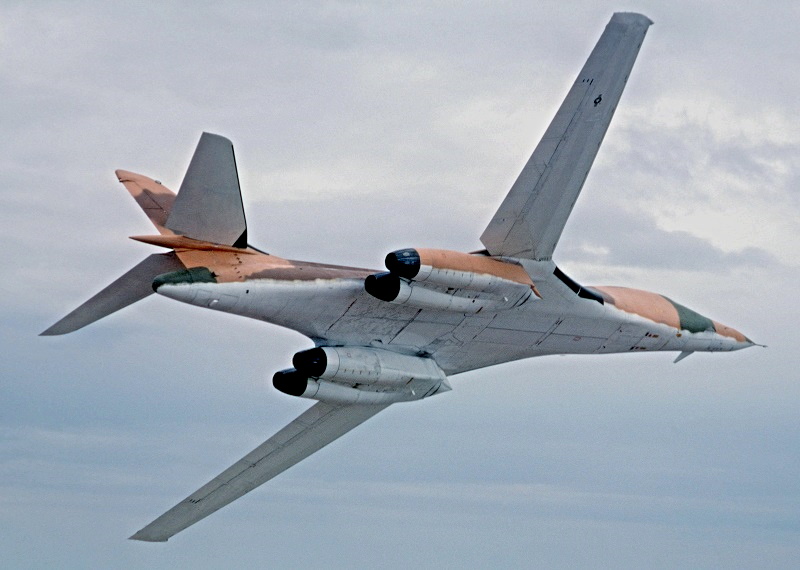
By the time of the first flight of the fourth prototype, however, the B-1 seemed all but dead. The 1970s saw a push for disarmament, and production of the B-1 was canceled by US President Jimmy Carter on 30 June 1977. The price of the B-1 had been creeping upward, and Carter believed that cruise missiles would be a cheaper nuclear deterrent. The four B-1 prototypes were to remain in flight test as a form of "insurance". The Air Force went on to conduct another series of studies. Rockwell proposed a cost-reduced version of the B-1 that had fixed wings and could be used as a nuclear or conventional bomber, or as a tanker. The Air Force didn't bite on that proposal, but was interested in an improved B-1 known as the "Long Range Combat Aircraft (LRCA)".
A resurgence of tensions with the Soviets and other factors led to the election of Ronald Reagan as US president in 1980. Reagan was committed to a major arms buildup, and this led to the resurrection of the B-1 LRCA as the "B-1B", which was promoted as a cruise-missile carrier though it still retained its free-fall nuclear bombing capability. The original B-1 prototypes were retroactively given the designation "B-1A". Reagan announced the decision to go ahead with the B-1B in October 1981, and formal contracts for a hundred production machines were finalized on 20 January 1982.
The second and fourth B-1A prototypes were to be used for B-1B development, with the fourth built up as the B-1B pre-production prototype. The second prototype was lost in a crash on 29 August 1984, killing the pilot, Rockwell chief test pilot Doug Benefield, and badly injuring the rest of the crew. Despite the accident, the program went forward. The first production machine performed its initial flight on 18 October 1984, with initial service delivery on 29 June 1985. The last of the hundred was delivered by the end of the decade, with five bomb wings operating the type. Although formally named the "Lancer", the B-1B became more generally known as the "Bone", from "B-One".
BACK_TO_TOP* The B-1B, as it emerged, was a sleek, dartlike aircraft with a variable geometry "swing wing", which could be extended to full span for take-off, landing, and long-range cruise, and swept back for high-speed penetration of adversary airspace. The swing wing did impose a weight penalty, but when extended it increased range and allowed the B-1B to use shorter airstrips -- assisting in dispersal of forces or forward-basing in time of war -- while giving the bomber a good smooth low-level ride in sweptback position.
Minimum sweep was 15 degrees and maximum sweep was 67.5 degrees. The junction where the wing swept into the wing glove featured a "seal" to ensure aerodynamic cleanliness. The sealing system was derived from that developed for the European swing-wing Panavia Tornado strike fighter / interceptor, and featured an inflatable bag covered with "fingers". The wing had lift-enhancement devices for relatively short take-offs with a full load, including seven-segment full-span extensible leading-edge slats and six-segment trailing-edge Fowler-type flaps. There were no ailerons, with four spoilers on the top of each wing used to provide roll control and as airbrakes.
The tail was of conventional configuration, with an all-moving tailplane and a single tailfin. The rudder had three sections, and the tailplanes could pivot in opposite directions to help with roll control. They could also be turned to their maximum nose-down position to act as an airbrake on landings.
There were small moveable vanes made of composites alongside the nose, with an anhedral droop of 30 degrees, referred to in an opaque way as the "structural mode control system (SMCS)" foreplanes. They were fitted because the long B-1B fuselage tended to flex fore-and-aft in low level flight. The SMCS vanes were linked to a set of accelerometers near the center and nose of the bomber under computer control to ensure a smooth ride at low level, increasing crew comfort and airframe life.
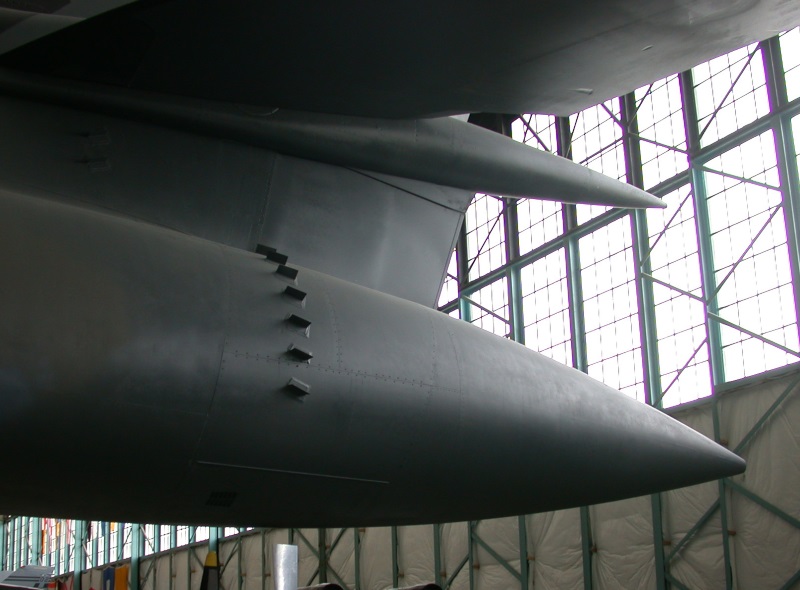
The keen-eyed could also notice a set of small fixed fins partly ringing the tailcone. These were not antennas, being instead "vortex generator" vanes that broke up stagnant airflow over the "boundary layer" next to the surface of the tailcone. Vortex generators are often seen on aircraft wings to ensure that they maintain lift at low speeds, but it is unclear why boundary layer separation was a problem over the B-1 tailcone; they may have been to reduce buffeting or wake drag.
There were eight self-sealing fuel tanks, filling up much of the fuselage and parts of the wing assembly. Additional fuel tanks could be installed in the weapons bays. All fuel tanks were pressurized with inert nitrogen to reduce fuel explosion hazard. The B-1B's "Fuel & Center Of Gravity Management Subsystem (FCGMS)" shifted fuel from one tank to another to maintain trim when the aircraft changed the sweep of its wings. There was a midair refueling socket in the nose, just forward of the windshield. The position of the socket allowed the bomber's flight crew to keep an eye on a tanker's refueling boom. The top of the nose was painted with a white "fishbone" pattern to help a tanker boom operator locate the bomber's refueling socket at night.
The B-1B was made mostly of aluminum alloy and titanium, with a few composite elements. The central "box" that supported the swing wings was made of titanium. The aircraft was structurally reinforced to withstand the shock of a nuclear blast. The fuselage had smooth contours, with wing-body blending, and used radar absorbing material (RAM) to give it a radar cross-section only about one or two percent of that of the B-52. While the original prototype B-1As flew in a natty white anti-nuclear flash or a multi-tone camouflage paint scheme, operational B-1Bs were given dark color schemes, eventually standardizing on an overall "gunship gray" paint job.
The B-1B was powered by four F101-GE-102 afterburning bypass jet engines with 75.6 kN (7,710 kgp / 17,000 lbf) dry thrust and 136.9 kN (13,960 kgp / 30,780 lbf) afterburning thrust each. The B-1B could fly on only two engines if necessary, and could even stay in the air on one if most of the fuel was dumped.
The engines were organized into two pods with two engines each, mounted under the rear of the wing root gloves. Engine bleed was distributed throughout the aircraft for cabin pressurization and a range of other purposes. There was an auxiliary power unit (APU) mounted between the engines in each pod, primarily to start the engines, though the APUs could also be used for ground power. The APUs allowed a quick startup of the engines so the bomber could get off the runway in a hurry. There was a switch on the nosewheel gear that a crewman could slap to get the APUs and engines going even as the crew was getting into the bomber. A single APU could fire up all four engines.
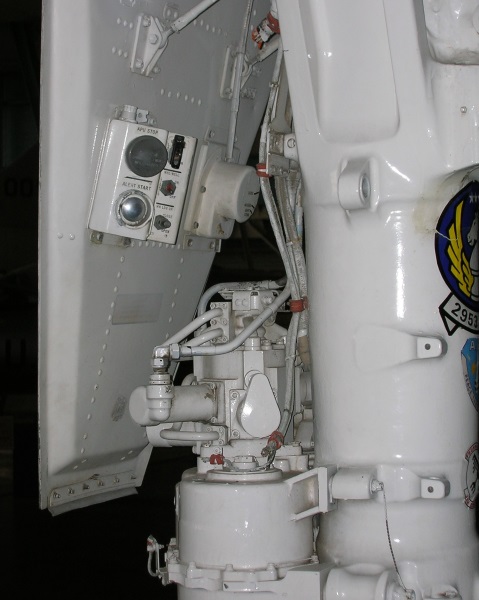
The engines had fixed inlets, instead of the variable inlets of the B-1A. The B-1A had been designed to perform high-altitude penetration at dash speeds in excess of Mach 2, but that was unrealistic even at the time, and though the B-1B's fixed inlets cut the high-altitude dash speed to Mach 1.25, they raised its low-level speed from the B-1A's Mach 0.85 to Mach 0.92. The B-1B's inlets were also designed to shield the engine fans from radar to improve stealth. The inlets featured a de-icing system.
One of the interesting minor details of the B-1B was that the Bone was originally delivered with "turkey feathers" shroud around the variable engine exhaust. The shroud was removed in the 1990s as a weight and maintenance reduction measure, leaving the variable exhaust actuators exposed.
The B-1B had tricycle landing gear, with twin-wheel nose gear and main gear featuring four-wheel 2-by-2 bogeys. The steerable nose gear retracted forward, while the main gear retracted into the center of the aircraft. The landing gear was reinforced from the B-1A to handle greater take-off weights. Carbon brakes were fitted to reduce landing roll.
___________________________________________________________________
ROCKWELL B-1B:
___________________________________________________________________
wingspan, extended:
41.67 meters (136 feet 8 inches)
wingspan, swept:
23.84 meters (78 feet 2 inches)
length:
44.81 meters (147 feet)
height:
10.36 meters (34 feet)
empty weight:
87,090 kilograms (192,000 pounds)
MTO weight:
216,365 kilograms (477,000 pounds)
max speed:
1,330 KPH (825 MPH / 720 KT)
penetration speed (at 60 meters / 200 feet):
965 KPH (600 MPH / 520 KT)
service ceiling:
> 15,250 meters (> 50,000 feet)
unrefueled range:
12,000 KM (7,455 MI / 6,485 NMI)
___________________________________________________________________
* The B-1B was equipped with three weapons bays that could carry a total of up to 34,020 kilograms (75,000 pounds) of munitions. There was a partition between the two forward weapons bays that could be moved or removed to permit carriage of different types of stores, including cruise missiles.
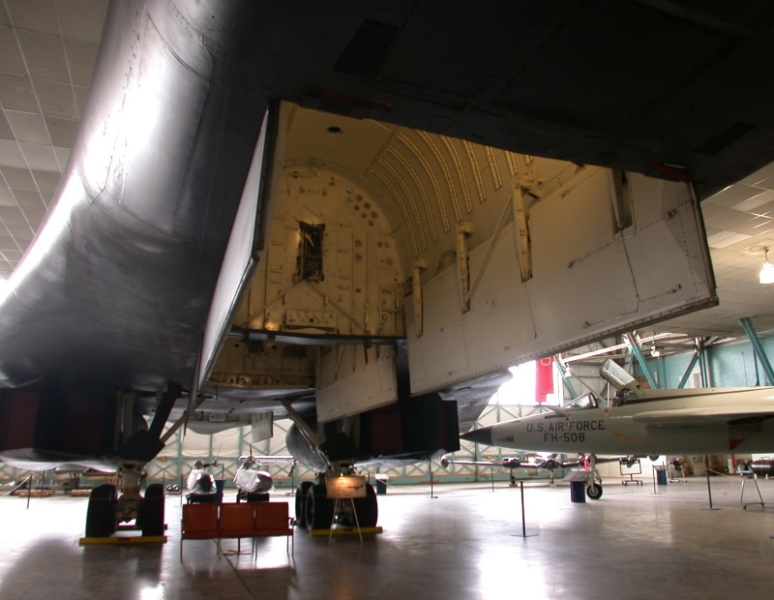
The B-1B was originally tasked for delivery of free-fall nuclear weapons, with each bay carrying a single "Multi-Purpose Launcher (MPL)" with a capacity of eight nukes -- 24 nuclear weapons providing a staggering level of firepower. The bomber could carry up to 24 Short Range Attack Missiles (SRAM), but SRAM was retired in 1990.
As discussed below, there was some delay in qualifying the B-1B for conventional munitions. In principle, the B-1B could also be fitted with up to eight underfuselage hardpoints that could carry up to 26,760 kilograms (59,000 pounds) of munitions. In practice, it's never been done operationally.
* The Bone carried a crew of four, including pilot, copilot, "defensive systems operator (DSO)", and "offensive systems operator (OSO)". The pilot sat on the left in the forward compartment, with the copilot on the right. The DSO sat on the left in the rear compartment, with the OSO on the right. The two compartments were connected by a tunnel, which could be used as a sleep station on long missions. Although the B-1A had no windows in the rear compartment, test crews claimed that this made the place feel claustrophobic, and so the B-1B had a small window on each side of the rear compartment.
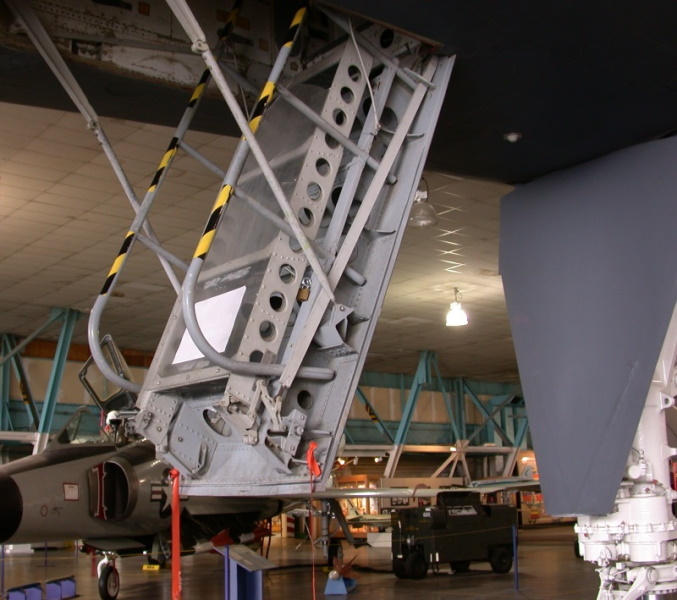
The crew entered the bomber through a hatch with an integral ladder behind the nosewheel bay that opened into the rear compartment. Crew accommodations were much more comfortable than those of the B-52, and the cockpit was regarded as well laid out, with a clean dashboard arrangement and fighter-style stick controls for pilot and copilot. A toilet and galley were provided to support long missions, and there was space for two instructors along with the crew of four. However, the instructors sat on fixed seats, meaning they had to bail out manually in case of an emergency. After the deaths of two instructors in a crash in 1987, USAF procedures were changed so that only four crew were taken on low-level training missions.
The large, sloping windshield had an electrical demisting and deicing system, and was reinforced against birdstrikes, a big threat in low-level flight. All windows could be covered with nuclear flash shields, with the shields featuring zirconium titanate ports to permit some vision out. While the first three B-1As featured a crew escape capsule, whose malfunction led to the fatal results in the loss of the second B-1A prototype, it was judged unstable at high speeds, and so the B-1Bs used individual upward-ejecting Weber ACES II ejection seats, this configuration being trialed on the fourth B-1A.
* The B-1B's avionics suite was more sophisticated than that of the B-1A. The "Offensive Avionics System (OAS)" used by the OSO was integrated by Boeing. One of the main elements was the Westinghouse AN/APQ-164 multimode offensive radar system, derived from the AN/APG-66 radar used on the F-16 fighter. The AN/APQ-164 featured a phased array antenna, mounted in the nose of the bomber; and "low probability of intercept" operation, including the capability to take single "snapshot" sweeps, or partial sweeps. The radar had eleven modes, including terrain-following; navigation; tanker rendezvous; and targeting with a "synthetic aperture radar (SAR)" imaging capability.
The B-1B's original navigation systems include a precision inertial navigation system (INS), TACAN and ILS, and a Honeywell AN/ASN-121 radar altimeter. Honeywell also provided the offensive and defensive system displays, which included three color multifunction displays (MFDs). Two of the displays were used by the OSO, while one was used by the DSO.
The DSO relied mainly on the Eaton "Defensive Countermeasures System (DAS)", which included an AN/ALQ-161 receiver / jammer set; a tail warning radar; and an AN/ASQ-184 defensive management system, which could automatically control jamming functions and dispersal of chaff or flares from the "expendable countermeasures (EXCM)" system. There were eight dispensers arranged over the B-1B, with each dispenser having a capacity of twelve flares or 120 chaff cartridges. The DSO and OSO were cross-trained to do each other's job as need be.
The B-1B also carried an extensive communications suite, including an Air Force Satellite Communications (AFSATCOM) link. There were a number of blade antennas for the communications and defensive countermeasures that slightly disfigured the Bone's elegant contours. Most of the electronic systems were linked by quadruple-redundant MIL-STD 1553 data buses, and all were "hardened" to allow them to operate through the electromagnetic pulse (EMP) accompanying a nuclear blast, or other sources of electronic interference.
Other features of the B-1B included a "central integrated test system (CITS)" to help maintain the bomber; an "on-board oxygen generating system (OBOGS)" to eliminate the need to stock oxygen bottles; and a redundant hydraulic system.
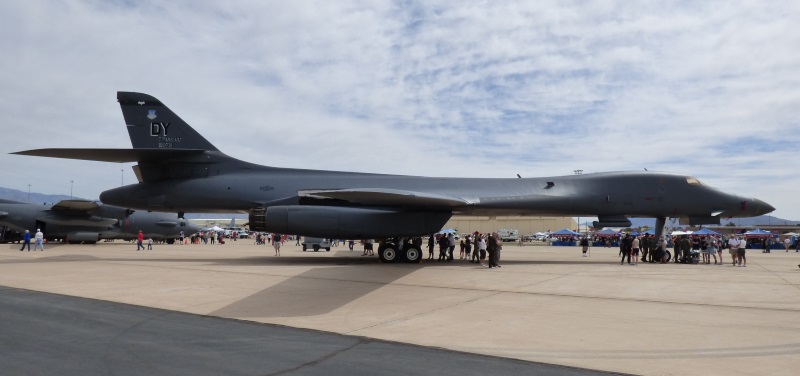
* Aircrew became fond of the Bone, the machine being said to fly very nicely for an aircraft of its size, with one USAF test pilot commenting: "Sometimes you've got to stop and think how big this aircraft is before you do some things, because it handles so well." Another told an interviewer:
BEGIN_QUOTE:
When you slam the throttles forward, you feel the afterburners kick in, which then presses you back hard against the ejection seat. Because of the different wing sweep settings, [the B-1] feels like two or three different aircraft. With the wings fully forward, it flies like the massive aircraft that it is -- with slow roll rates, limited gee, still with a relatively impressive power advantage, which requires a lot more careful attention and skill because the margin for error is less.
However, down low, she's an absolute monster. With the wings pinned aft, she's surprisingly agile, and the engines are unbelievably powerful. As a pilot, you pride yourself in listening to the feedback the aircraft gives you -- and from my experience, the Bone is the most joyful fast and low.
END_QUOTE
Apparently, when lightly laden and put into afterburner, it could climb like a bat out of hell. Yet another B-1B pilot commented:
BEGIN_QUOTE:
The B-1B is a big bird, but is actually quite maneuverable. The weapon bays are all internal, so we don't have any additional drag, even when fully loaded. The jet enjoys flying fast and low, contrary to the picture some people may have of the flight profile of a large bomber -- flying high and slow like the B-52 or B-2. People within the B-1B community have described it as a very fast [Northrop T-38 Talon trainer].
... We train a lot for [fast & low flight]. It's also the most dangerous and challenging element of our flying.
END_QUOTE
BACK_TO_TOP* The B-1B initially proved very controversial in service. There were a number of losses from accidents, along with high-profile groundings due to such problems as fuel leaks. The DAS system was particularly troublesome, demanding a series of expensive upgrades. Even after the worst problems were worked out, the bomber's availability rate was low, ground crews admitting that the big, complicated machine was maintenance-intensive. The Air Force defended the program, accurately pointing out that even the good old dependable B-52 had suffered its share of teething problems in its early days, and that inadequate funding for B-1 spares was a big part of the availability problem. However, the criticisms continued. As if to add to the USAF's embarrassment, the B-1B did not see combat service during the Gulf War in 1991, the B-52 performing all the heavy bomber strikes, despite the fact that the B-1B had in principle a conventional attack capability.
The bomber had been qualified early on to carry Mark 80 series "iron" bombs and comparable mines. The smaller Mark 82 225-kilogram (500-pound) bombs, and the Mark 62 mines based on the Mark 82, were carried in what amounts to a "clip", known as a "Conventional Bomb Module (CBM)". Each CBM could store 28 munitions and one CBM could be loaded into each weapons bay, for a total warload of 84 munitions. The big 900-kilogram (2,000-pound) Mark 84 bombs, and the comparable Mark 65 mines, were carried on a "Conventional Rotary Launcher (CRL)". Each CRL could carry 8 munitions, for a total warload of 24 munitions. More munitions could be carried on the external hardpoints, but as noted they've never been fitted in practice.
Incidentally, reloading munitions into a Bone was, at least early on, a troublesome procedure. According to the story, since the B-1 was originally designed for the strategic nuclear strike role, not a lot of thought was given to the reloading issue; the assumption was that after the first wave of strikes, the B-1B would have nowhere left to go to reload. That seems a little short-sighted, and may be a tale.
* In any case, the reason that the B-1B didn't go into action in the Gulf War was primarily because the USAF reserved the aircraft for nuclear strike, where its superior ability to penetrate enemy airspace made it preferable to the B-52. The B-1B's conventional strike capability was rudimentary, and that mission was better performed by other platforms. Unfortunately, that policy led to more criticism from the US Congress. There was some justification for the criticism, since the fall of the USSR meant that the Air Force needed to de-emphasize the deterrent role and focus more heavily on fighting the seemingly endless "dirty little wars" that followed the end of the Cold War.
In consequence, the USAF focused on improving the Bone's conventional strike capability, beginning the B-1B "Conventional Munitions Upgrade Program (CMUP)" in 1993. CMUP was implemented as a series of "block" upgrades. "Block A" was defined as the pre-CMUP B-1B, with subsequent blocks defined as follows:
* In 1995, to demonstrate that the B-1B was finally coming of age as a first-line aircraft, the Air Force conducted a round-the-world flight with two Bones that broke records. The two bombers made simulated attacks on ranges in Italy, the western Pacific, and the US state of Utah.
The B-1B finally went into combat in December 1998, as part of the four-day series of attacks on Iraq designated Operation DESERT FOX, performing six sorties and dropping iron bombs. It went back into action just a few months later in the spring of 1999, as part of the NATO air offensive against Serbia over the fighting in Kosovo, codenamed Operation ALLIED FORCE. The B-1B performed over a hundred sorties, also dropping iron bombs. Cluster bomb canisters were carried but not actually used in action.
The B-1 performed excellent service during Operation ENDURING FREEDOM, the Afghanistan campaign in 2001:2002. The bombers would fly out of the island of Diego Garcia in the Indian Ocean loaded with JDAMs, then orbit the battle theater, waiting to be informed of a target. The flight crews would receive targeting information over a data link, load it into bombs and set fuzing options, and then proceed to the target area to drop the bombs. They would then return to orbit and wait for a new target. Although there was no real opposition in the air to US forces, one B-1 was lost in early December 2001, due to an engine fire that occurred shortly after take-off. The four crew members ejected and were recovered safely.
The B-1 was heavily involved in Operation IRAQI FREEDOM, the invasion of Iraq in the spring of 2003. Although B-1s only flew 2% of the sorties, they dropped 2,100 JDAMs, or half the total expended. Each B-1 carried 24 900-kilogram (2,000-pound) JDAMs, usually split between penetrators with short delay fuzes and contact detonated bombs. About a dozen B-1Bs were flown from Oman in support of the operation, being used in "quick reaction" strikes in attempts to kill Iraqi leadership. The main problem with the 900-kilogram JDAM was that it was far too destructive for attacks on urban targets. A smaller munition was required, and in 2005 the Air Force introduced carriage of a 225-kilogram (500-pound) JDAM on the B-1. This fit required no changes in software, but it did dictate modifications to bomb racks.
As the conflict in Iraq stretched out, the Bone became a highly preferred weapon, in effect a strategic bomber operating in the tactical close support role. It could carry a heavy warload of guided munitions and loiter for long periods of time, dispensing bombs on request for pinpoint strikes on targets. Given the large bombload and the aircraft's endurance, which substantially reduced the need for inflight refueling, it was surprisingly cost-effective as a tactical support weapon.
It also proved useful in simple intimidation: troops would call in a B-1B to perform a fast low-altitude pass over an area infested with hostiles, with the thunderous noise of a huge dark aircraft streaking overhead and tossing out flares proving entirely unnerving. Certainly, the type has more than lived down its early disappointments as a conventional strike aircraft.
One problem that showed up in the Afghanistan and Iraq operations was that B-1 aircrews had no way of directly confirming a target themselves before weapons release, requiring the crew to call in a fighter to check the target, a process that was inefficient and still prone to deadly errors. With the B-1B continuing in intensive combat, the Air Force set up a fast-track program to qualify the Lockheed Martin Sniper XR targeting pod on a B-1B, mounted on one of the forward fuselage pylons -- they were good for something after all -- with the pod going into service in late 2008.
The targeting pod could be used to confirm targets, evaluate strike damage, and perform high-precision strikes with laser-guided bombs (LGBs). It was controlled by the OSO using a hand controller and a laptop computer, with the DSO having a laptop as well as a backup. The Sniper pod proved to be what was called an "operational game-changer" for the B-1B.
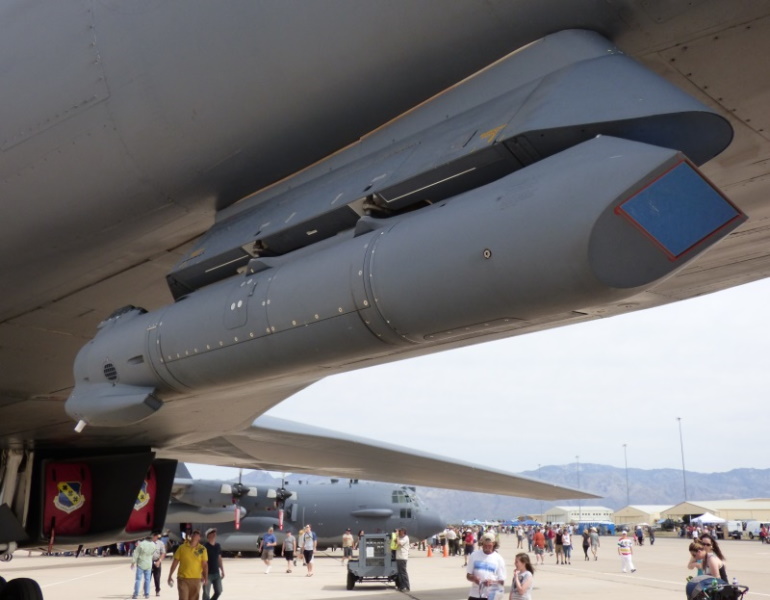
Other upgrades have been performed, such as structural updates, including replacement of the dorsal longeron -- the B-1's spine, in effect -- and new, stronger lower wing skins. There were also updates to ejection seats to deal with potentially dangerous behaviors.
Avionics updates included modernizations to the AN/APQ-164 radar under the "Radar Modernization Improvement Program (RMIP)"; replacement of the onboard diagnostics computer; and replacement of the inertial navigation system. Munitions updates included a new "multiple ejector rack (MER)" for the 225-kilogram JDAM, allowing the B-1B to carry 48 JDAMs; it was previously limited to 15. There has been consideration of the carriage of the 112-kilogram (250-pound) "Small Diameter Bomb", a lightweight GPS-guided glide bomb; the Bone would be able to carry up to 144 such munitions. Status of this effort is not clear.
In 2014, the Air Force began an upgrade program, run by Boeing, on the B-1B fleet to install a "Integrated Battle Station", which included:
The Integrated Battle Station upgrade was completed in 2020. In 2015, the USAF announced the replacement of the AN/APQ-164 radar with the Northrop Grumman "Scalable Agile Beam Radar -- Global Strike (SABR-GS)", an "active array" radar that will be more capable and reliable. SABR-GS was a derivative of the AN/APG-83 SABR developed for the F-16 fighter, but about three times bigger. Status of this effort is also not clear.
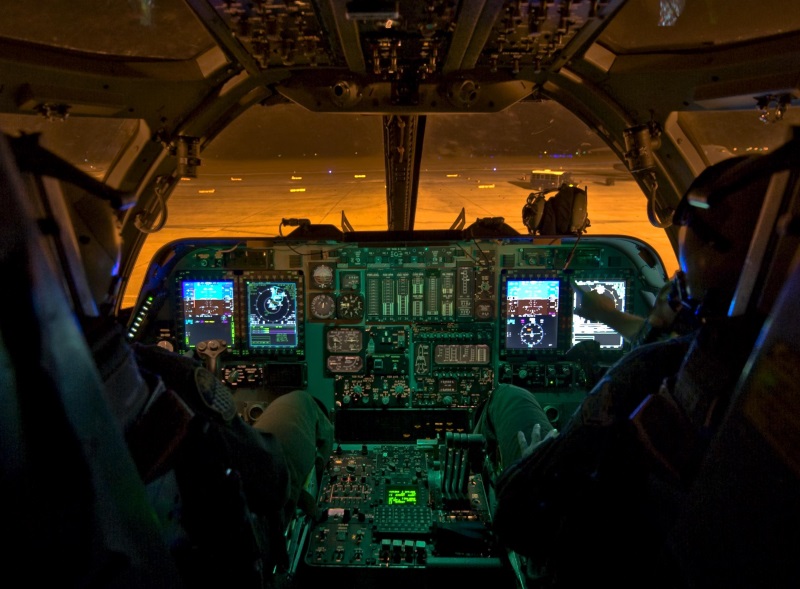
* While bombers like the B-52, B-1, and B-2 proved to be highly valuable assets in the widespread small wars that followed the collapse of the Soviet Union, these conflicts have not required great fleets of such aircraft. In 2002, the Air Force decided to withdraw 33 of the 91 B-1Bs surviving in service. Eight of the 33 were used as static display pieces, with the other 24 sent to the "boneyard" at Davis-Monthan AFB in Arizona -- some being in recoverable storage, others to be stripped for parts and then scrapped.
The number of B-1B bases was reduced from five to two, including Ellsworth AFB in South Dakota and Dyess AFB in Texas. Some of the retired machines were returned to service, but in 2021, 17 more B-1Bs were retired -- 13 going to Davis-Monthan, 3 being used for tests and experiments, and 1 going on display. That left 45 Bones on active duty.
No more will ever be built. In 2004, Boeing presented the Air Force with a concept for a "B-1R", where "R" stood for "Regional", which would be fitted with the Pratt & Whitney F-119 engine used on the F/A-22. Four F-119s would give the B-1R a top speed of over Mach 2 and an operational radius of 4,800 kilometers (3,000 miles). It would feature improved stealth features and countermeasures, state-of-the-art radar, AIM-120 AMRAAM missiles for self-defense, and a new light air-to-surface standoff missile.
The Air Force was simply considering options, to finally decide to replace the B-1 -- and the B-2 -- with the Northrop Grumman B-21 Raider flying wing bomber, with the B-1 to be out of service no later than 2036. That's a long time, and obviously plans may change. Ironically, the B-52H is slated to stay in service to mid-century, since it's just the most cost-effective delivery platform, as long as it doesn't have to confront adversary air defenses.
BACK_TO_TOP* The first time I saw a B-1 was the most memorable, if the most fleeting. I was on the way south across the barrens of Wyoming, a land of great empty spaces where USAF bombers like to prowl, and driving up a hill. At the top of the hill the road met the sky, flanked by tall banks on either side.
As I started up the hill, a slender black dart zipped from one bank to the other. I floored the gas pedal to get to the top of the hill as fast as I could, but I knew it was pointless: by the time I reached the top and looked out over the badlands, the machine was long gone over the horizon. I only saw the thing for a flash, but I had no doubt of what it was.
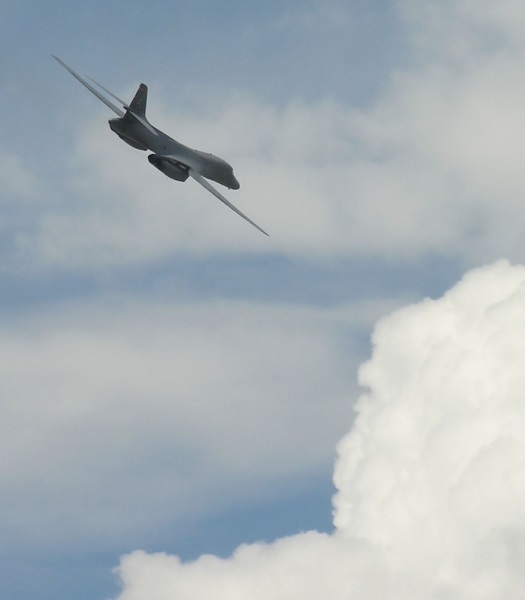
* Sources include:
* Illustrations details:
* Revision history:
v1.0.0 / 01 feb 03 v1.0.1 / 01 jul 04 / Review & polish. v1.0.2 / 01 jul 06 / Review & polish. v1.0.3 / 01 aug 08 / Review & polish. v1.0.4 / 01 jul 10 / Review & polish. v1.0.5 / 01 jun 12 / Review & polish. v1.0.6 / 01 may 14 / Review & polish. v1.0.7 / 01 apr 16 / Review & polish. v1.0.8 / 01 jun 18 / Review, update, & polish. v1.0.9 / 01 may 20 / Review, update, & polish. v1.1.0 / 01 feb 22 / Review, update, & polish. v1.1.1 / 01 jan 24 / Review & polish.BACK_TO_TOP
